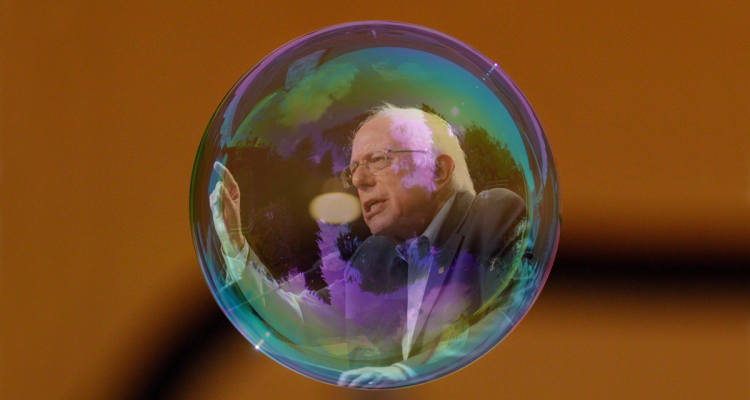By: Richard W. Sharp & Patrick W. Zimmerman
America, it’s time to talk about your bubbles.
Most people tend to surround themselves with like-minded folk; we like hearing confirmation that our views and analysis of the world around us are shared by others. So what? Well, there are a couple problems: filtered information leads to skewed analysis, which leads to bad decisions, and bubbles also increase their members’ susceptibility to fake news and magnify its virulence.
The Resistance has been a social-media bubble fueled political crusade, mobilizing millions (literally, in some cases) through the use of hashtags like #resist, through a plethora of Facebook groups, and through the organic distribution of news out of those groups by interlocking friend networks. Their opponent, President Trump, equally spends much of his time in a MAGA-themed echo chamber, fed positive news stories every morning to help him start his day with a smile.
The magnifying power of groupthink serves to help keep people already opposed to the regime exposed to a relatively constant stream of news, opinions, and information about it. Bubbles create positive feedback loops where adherents to a particular ideology or stance on an issue selectively encounter views that both agree with their own and those that are diametrically opposed, both of which tend to harden and reinforce belief. To create a political bloc, one could do worse than to filter someone’s information stream to selectively show yes men and strawmen.
So, it’s clear that political polarization has been steadily rising in the US since the turn of the century, and social and social media bubbles have been much discussed, and frequently blamed for this. But people rarely attempt to define or measure those very bubbles, treating them more like nebulous boogeymen.
Let’s go and do that.
The question
How does the view from inside the Resistance bubble(s) compare to the national average?
Can we even define a coherent group of bubbles on the left, and what does that mean for any Democratic candidate in either 2018 or 2020?
The short-short version
Well, surprise, surprise! The left lives in a bubble too, but it’s much harder to identify because its members weren’t considerate enough to stand up and announce themselves so clearly last November.
By examining the opinions of Clinton voters on a range of issues as compared to a number of other segmentations of the public we find a fragmentation of bubbles among the left, each with different priorities.
That’s a lot of cats to try and herd by 2020.
Want to jump straight to the results? Click here.
Chasing the Resistance bubble
The first trick, of course, is to define the Resistance itself, which is a little harder than we first thought. Is it an anti-establishment movement within the Democratic party, or is it a broad collation held together in opposition to Trump? Does it consist of Benrie backers, Clinton supporters, both, or neither?
We’ve already taken a look at the the Resistance’s right-wing counterpart, the MAGA movement, but that was a well-defined and heavily-polled segment of the right: the enthusiastic Trump voter, the anti-establishment wing of the Republican party. Easy to identify, easy to poll.

Inferring bubbles from their shadows.
Things are a bit more fragmented on the left. We’re not even sure who really counts as part of the Resistance in politics. It lacks a clear champion. Bernie Sanders had his turn in the sun, but he is not the face of the Resistance (he’s actively despized by certain sections of it). Perhaps Elizabeth Warren comes closest, but whoever ends up being the candidate-to-be-named-later must chart a narrow course to avoid miscalculating either the true nature of the movement (in the primary) or the mood and tastes of the general electorate. This uncertain identity means that little reliable (or even unreliable) polling exists of “people who have protested against some aspect of the Trump Regime.” There are no ethnographic studies of the Women’s March.1 The challenge, then, is creating an approximation from existing data.
The polling that is out there identifies women and young voters as key components of the resistance (defined as groups more likely than others to have engaged in protest or action against the Trump regime following the election). But there are several other possible constituencies:
- The establishment: Clintonistas.
- The anti-establishment: Berners.
- Predecessor and contemporary movements: Occupy Wall Street, Black Lives Matter, or Antifa.2
We haven’t found access to direct polling of these groups with respect to resistance activities and priorities, so we will take a softer approach. As a proxy, we will infer the existence of lefty bubbles from polling about various issues broken down along several demographic axes.
An imperfect source: The Harvard-Harris poll
Fortunately, the Harvard-Harris poll took up the task of polling many of these issues across a wide range of demographics in 2017. Each month, the poll asks respondents about their opinions on a range of issues and records their personal and political characteristics.
Unfortunately, the raw results of the poll are not available, so we are unable to isolate the left-leaning population. For example, we cannot directly measure how female Democrats feel about single-payer health care, the state of the economy, or Black Lives Matter. Instead, we will take a look at how the opinions of each group (by gender, age, ethnicity, party affiliation, political orientation, education, locale, and income) compares to the opinion of the generic Clinton voter.3
All of the population segments (e.g. 18-34 year-olds or women) are a mixture of individuals from the right and the left, so their responses in aggregate are expected to be more conservative than those of the Clinton voter. But it’s not the bias that interests us, but rather the consistency of the bias across the range of issues. In segments such as women or Hispanics, which lean Democratic, a disparity of opinion (lying to the left of the Clinton voter on one issue, but to the right on another) reveals a diversity of opinions on the left. These differences hint at the bubbles which produce them.4
Who are the champions?
Let’s start by taking a look at the standard bearers from the last Democratic Primary, Clinton and Bernie, simultaneously the least and most popular politicians in the country, respectively, in terms of favorability ratings. Clinton, of course, is viewed favorably by Democrats, and it is the extremely negative view of her held by Republicans and Independents that sinks her overall numbers. Bernie’s support has a significant number of Independents, whereas Clinton performs better with minorities, especially blacks and African-Americans.
The charts below let us compare the views of the Clinton voter to those of several segments of the general population: by gender, age, and ethnicity. This helps reveal another skew between the populations: Bernie enjoys proportionally more support among men than Hillary. That is, the Bernie’s difference in favorability between men and women is roughly the same as the difference in favorability for the Democratic party as a whole, but the bias for women toward the Democratic party is not enough to explain Hillary’s favorability gap between the sexes.
Note on reading these charts: A +41% measure below (to take one example) means that “the difference between Clinton’s favorability among Clinton voters and men was 41%.” In other words, bars that extend to the right indicate a position to the political right of the Clinton voter and bars that extend to the left are politically to the left of the Clinton voter.
Health care
Health care is a polarizing issue.
Well, actually… No. It isn’t.
There are plenty of polls out there showing that Americans support the idea of government regulation of health care, and even in the form of a single-payer system. Support is strongest among Democrats and non-whites. On the other hand, opinions about Obamacare and about Bernie and Warren’s call for a single-payer system are strongly affected by partisianship, as any move towards them would mean points for the left and demerits for the right.
The complications disentangling policy positions from the people who advocate them shows up among men, 35-49 year-olds, and blacks and African Americans in the Harvard-Harris poll. Rephrasing the question about healthcare to include “Elizabeth Warren and Bernie Sanders are advocating” before saying “single-payer” increases support for the measure just by virtue of the name-drop. It has the opposite effect (decreases support) on women, 18-34 year-olds, and Hispanics. The effects are mild, but this is the kind of indication we’ve been looking for to suggest a diversity of opinions on the left.
Economic outlook
Economic issues are where we start to find some groups that lie to the left of the Clinton voter. The Harvard-Harris poll asked a number of questions about the economy and the general state of the nation, but two in particular stand out: “Would you say that your personal financial situation is improving or getting worse?”and “How strong do you think the U.S. economy is today?”
The personal finance question is one of the few dimensions along which several groups lie to the left of Clinton voters taken as a whole. Hispanics, women, those 35-49, Independents, liberals and moderates, third-party voters, those with some college or less education, residents of rural areas, and those with income below $75,000 all have a more pessimistic view. Or in other words, Clinton voters have a more positive view of their personal financial outlook than many other groups, which is consistent with an establishment faction within the group (the donor class).
Only one group, blacks and African Americans, held a more negative view on the state of the economy than Clinton voters, although the opinion of their personal situation was at the same level as Clinton voters. Hispanics reversed this pattern, holding a more strongly negative outlook on their personal financial situation (indeed, the most strongly negative outlook of any group). Both groups tend to vote Democratic, and both are clearly concerned about the economy (actually, everybody is concerned if you check the topline numbers), but the nature of their concerns are distinct. A solution that appeals to one group may do little to address the concerns of the other. Here is evidence of a bubble that lies beneath, though not a clear picture of its limits.
The poll also asked people if they considered themselves socially and fiscally liberal or conservative. In this regard, there is also a clear pattern: of consistency. Every group contains more fiscal liberals than social liberals (except the group of self-identified liberals themselves, they are at least consistent here and identify as fiscal and social liberals as well).
Race
The Harvard Harris poll also tracked issues related to race relations, asking, in particular, for respondants’ views on the Black Lives Matter movement. This is one of the few chances to take a direct look at one of the proposed constituencies of the Resistance by looking at BLM favorability numbers.
Generally speaking, the BLM numbers are not good among the general population, though not in HRC territory. The major exception is among blacks and African Americans who hold a view far to the left of all other groups on this issue. There is also a strong effect when the numbers are broken down along age: 18-34 year-olds as a group are pretty close to Clinton voters on this issue, but older age segments view BLM much more unfavorably.
Conclusion
So let’s take stock. We started off looking for the belief boundaries of the Resistance, but ended up not at all certain that there is a coherent Resistance movement. While women and the young have been identified as significant contributors, we witnessed the shadows of several groups on the left, characterized by a candidate, gender, ethnicity, or age. The issues that matter to each of these are independent of one another (within the context of a general leftward tilt). Polling in this area is far from complete.
The problem is: if the Resistance is to make progress, if good strategic decisions are to be made, then a good understanding of the members and beliefs of the movement, the bubble, is essential.
Is it true that what’s bad for Trump is good for the Resistance? That is, will his disaster of a presidency lead to gains at the ballot box? It’s probably not quite that simple. Although we reflexively frame political debate in red and blue, a strong current of populism vs. the establishment has cut through both parties. So Bernie would have won, right? Well….it’s totally unknown. Bernie would have triggered a radically different reaction. While he would have drawn more support from the center, important sections of the Democratic base would not have been mobilized. In particular, Bernie turned off the “donor class” identified above, those wrascally people who have plenty to lose from blowing up the status quo. The long-term appeal of anti-establishment votors to any one politician is also uncertain. In the recent Republican primary in Alabama, voters swerved right, abandoning Trump. Good strategy with incomplete data is a tall order.
Then there is the dark side of the bubble.
We’ve talked about the importance of understanding collectively held beliefs for the sake of making good strategic decisions, but we also now know that there are those who use this information to act against the interests of the group. The government doesn’t want you to know, but … wait … the government does want you to know (at least part of it does):
– Director of National Intelligence
As members of a bubble (we’re all members of bubbles) we choose to limit our sources and lose sight of the big picture. As a result, we make ourselves susceptible to manipulation.
The object of the constructive is to build a coalition, a significant challenge where numerous distinct interests need to find a common cause. The bar is much lower for the destructive, which seek to split the presumed group into its separate parts or to build a unified opposition. It is easy for the organs of the Resistance to succumb to temptation and, rather than challenge their assumptions, produce red meat for the base. But opponents will weaponize the abattoir.
Vive la résistance.
1 Heck, we’re not even really sure there is a single Resistance. Given the difficulty of studying the state, the “anti-state” is even more probematic.^
2 One of the few things you can’t sue in America is a social movement.^
3 What we do know of his tax situation isn’t grounds for confidence in the probity of his financial dealings.^
4 Why the Clinton Voter? This is preferable to self-identified Democrats or liberals in that one has put one’s money where one’s mouth is. These are people who have actually acted as an agent of the greater left, whether through conviction or in opposition to the right. The picture would be more complete if we were to include left-leaning third party candidates, however, this data is not available.^
5 Right leaning members of the group are unlikely to account for the disparity because it is easier to unify opposition to these left-leaning causes than to unify support. Furthermore, within groups where the right is underrepresented, their opinions are even less likely to account for the difference.^



No Comments on "Inside the Resistance Bubble"